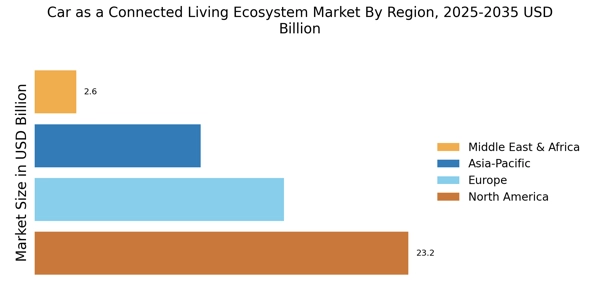Rise of IoT Connectivity
The proliferation of Internet of Things (IoT) devices is a primary driver for the Car as a Connected Living Ecosystem Market. As more vehicles become equipped with IoT technology, they can seamlessly connect with various smart devices, enhancing the overall user experience. This connectivity allows for real-time data exchange, enabling features such as remote diagnostics, predictive maintenance, and personalized driving experiences. According to recent data, the number of connected vehicles is expected to reach over 500 million by 2025, indicating a substantial growth trajectory. This trend not only improves vehicle functionality but also fosters a more integrated lifestyle for users, as their vehicles become an extension of their connected environments.
Integration of Mobility Services
The integration of mobility services is reshaping the Car as a Connected Living Ecosystem Market. As urbanization continues to rise, consumers are increasingly looking for flexible transportation options that go beyond traditional car ownership. Services such as ride-sharing, car-sharing, and on-demand transportation are becoming more prevalent, necessitating vehicles that can connect with these platforms. Data suggests that the mobility as a service (MaaS) market is expected to grow significantly, with projections indicating a market size of over 300 billion by 2030. This shift towards shared mobility solutions highlights the need for vehicles that can seamlessly integrate with various services, enhancing the overall connected living experience.
Focus on Data Privacy and Security
The focus on data privacy and security is becoming increasingly vital in the Car as a Connected Living Ecosystem Market. As vehicles become more connected, the amount of data generated and shared raises concerns regarding user privacy and cybersecurity. Manufacturers are now prioritizing the implementation of robust security measures to protect user data from potential breaches. Recent studies indicate that nearly 80% of consumers express concerns about data security in connected vehicles, prompting companies to invest in advanced encryption and security protocols. This emphasis on data protection not only builds consumer trust but also ensures the sustainable growth of the connected vehicle market.
Consumer Demand for Enhanced Safety Features
Consumer demand for enhanced safety features is a critical driver in the Car as a Connected Living Ecosystem Market. As awareness of road safety increases, consumers are seeking vehicles equipped with advanced safety technologies such as collision avoidance systems, lane-keeping assistance, and adaptive cruise control. These features are often integrated with connected vehicle systems, allowing for real-time updates and alerts. Market Research Future indicates that nearly 70% of consumers prioritize safety features when purchasing a vehicle, underscoring the importance of these technologies in the automotive sector. This demand not only drives innovation but also encourages manufacturers to develop vehicles that are safer and more connected.
Advancements in Autonomous Driving Technology
The ongoing advancements in autonomous driving technology significantly influence the Car as a Connected Living Ecosystem Market. As manufacturers invest heavily in developing self-driving capabilities, the integration of advanced sensors, machine learning algorithms, and real-time data processing becomes essential. This evolution not only enhances safety but also transforms the driving experience, allowing users to engage with their vehicles in new ways. Market data suggests that the autonomous vehicle segment is projected to grow at a compound annual growth rate of over 20% through the next decade. This growth indicates a shift towards vehicles that are not just modes of transport but integral components of a connected living ecosystem.


















Leave a Comment